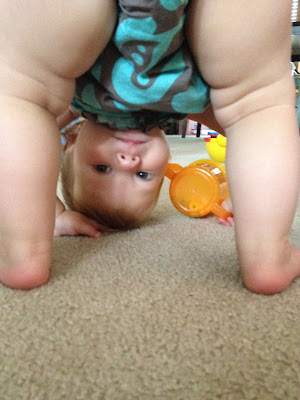Whining, throwing fits, defying, not cleaning up, not listening, blah blah blah. It's life with kiddos, right? Since I posted "
Operation Mommy Stop Yelling" on our family page, I've gotten several emails asking about the stop light.
First and foremost, the stop light works because it's a visual for the children. Kids need that. It's hard for them to remember what happened five seconds ago in terms of behavior, so seeing something visual helps remind them.
You can make the stop light how ever you want. We put ours on the fridge and made magnets with each child's initial on it. You'll notice Everleigh does not have one. She's too young for this...redirection is the method that works best at this point for her.
This is how the stop light works in our house:
Every day, you start on
green. Green means that you are behaving as expected. We use
lots of praise for being on green. You can also provide a reward for staying on green all day. We don't do that in our house
because I'm a mean mom because green is expected, but for some families with more severe behavior issues, rewarding with something for all day on green is a good idea.
Yellow is a warning. I say to my children, "If you don't stop ___, then I will place you on yellow." If they do (or don't do) it, then I move the magnet. You HAVE to follow through! Do not continue to warn them or threaten them. This is why you have the stop light in the first place...so you can stop yelling/nagging/reminding them! One warning is enough. The more warnings you give, the more opportunities they have to test you.
If they misbehave again, you calmly place them on
red. Typically, the sheer fact that the magnet (or whatever) is moved to red is devastating enough. However, you need to have a plan in place as to what happens when they get to red. And most importantly,
they need to understand what this is and
what this means before you start with this system.
For us, red means either sitting in a time out, getting something taken away, or not being able to do something fun.
I'm a huge believer in natural and logical consequences
(post on that soon--it's my favorite discipline technique)--- so I find a consequence that is as closely tied to the misbehavior as possible.
If they aren't playing nicely with a toy-- I'd take the toy away.
If they are hitting-- I'd place them in a time out.
If they aren't cleaning up-- then I'd take those toys away.
If they are writing a big "H" on the wall (ahem)-- then they'd scrub the wall, and not be able to use pencil's for the rest of the day.
Do you see how the consequence is directly linked to the misbehavior in most cases? And when you can't link it, like sassing, hitting, etc, then I give a time out.
You can choose whatever consequence works best for your family, as long as you always follow through! Well, not
whatever. Slapping them across the face really isn't a good idea, even if you do feel like it.
Again, the less yelling and negotiating, the better. DO NOT ask your child if they want to be placed on yellow or red. Give them a choice---
you stop doing ___ (or do ____ ) OR you will be placed on red. They decide if they want to make the "right" choice, and you follow through on what they decide.
Tonight, after two poor choices, Mad Mike's magnet looked like this.
And he had to sit in a time out. And to my surprise, he completed the time out and then apologized to us for taking his underwear off, whipping them at his dad, and yelling NO!
You might find that the stop light works for a period of time. We typically keep ours up for a couple of months, then we take it down for a while. When I find myself feeling frustrated, I put it back up. Yes, it's a tool for children to visually see their behavior, but it's also a tool to guide parents as well.
If I didn't answer your questions about the stop light, just leave me a comment and I'll do my best!
Good luck and I hope it helps!
~Brook































